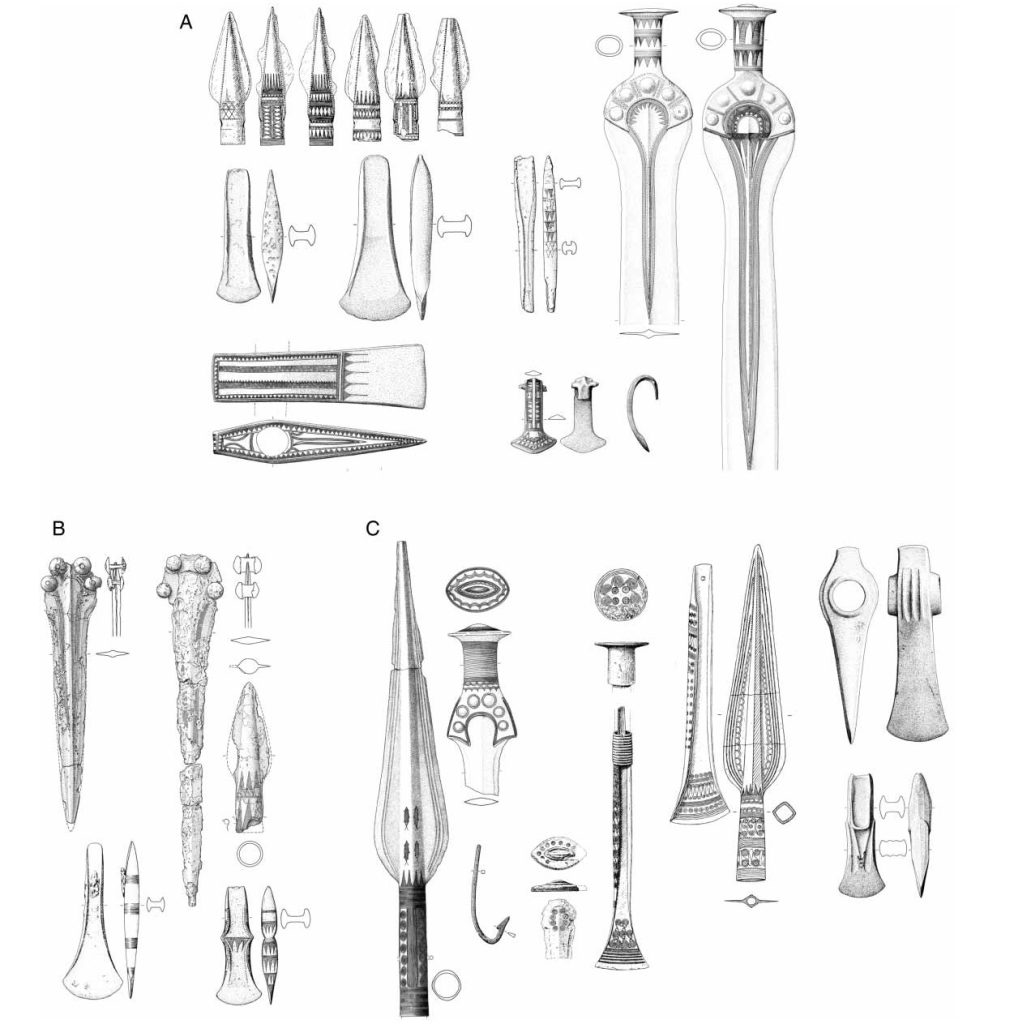Denmark, and most importantly the southern part of Jutland, has traditionally been part of the Sögel-Wohlde region in the early Nordic Bronze Age. In previous posts, we have already stressed the importance of swords belonging to the Apa-Hajdúsámson type from the Carpathian basin, as one of the main sources of inspiration for the Sögel-Wohlde metalwork. The influence of the Carpathian types in southern Scandinavia however was far reaching and more prominent. Denmark in particular has evidence of a multitude of metallurgical traditions beyond Sögel and Wohlde such as Fårdrup (A) and Valsømagle (C). These styles are all seen as ‘cultural translations’ under Carpathian influence. Of note is that this metalwork concerns weaponry consisting of swords, daggers, axes and spearheads.

Three main styles in southern Scandinavia of the Nordic Bronze Age period IB including Fårdrup (A), Sögel-Wohlde (B) and Valsømagle (C), including swords influenced by the Apa-Hajdúsámson tradition in the top right corner (Image courtesy by H. Vandkilde; Vandkilde, H., 2014)
Much of this metalwork has already been studied by Nørgaard (2021; 2023) with a focus on Fårdrup and Valsømagle types, which are predominantly found in Denmark. The Sögel-Wohlde metalwork is part of the same Nordic Bronze Age and the current project is filling in the research gap for period Ib. Previous sampling trips had a strong focus on Northern Germany and Central Europe. The latest journey took us back to northern Europe where we were allowed to visit the National Museum in Copenhagen, as well as the Museum of southern Jutland. Some of the included blades are absolute highlights of the early Nordic Bronze Age and their contribution to the project will be highly relevant. Not only for the Nordic Bronze Age itself but also its connection to different cultural groups in Central Europe and the Carpathian Basin. The best evidence for the relationship between the Nordic Bronze Age and more southern cultural groups comes, not only from decorations and styles, but also the occurrence of swords with a bronze hilt. Rare specimens have been found in Denmark including full-hilted swords from Stensgård and Torupgårde which are thought to be Carpathian imports, as well as blades with half-metal hilts from Roum, with equivalents in Rastorf and the well-known Nebra blades.

Sögel blade from the island Fur with a decorated pommel disk.
Their typological relationship has been part of the archaeological discourse for decades, showing that southern Jutland and Northern Germany were part of a cultural group that expressed their martial identity with similar styles of metalwork. However, the Danish metalwork did appear to deviate from the usual Sögel styles, suggesting a level of creative freedom away from cultural norms. All that rests is to figure out whether the Scandinavian part of the Nordic Bronze Age Ib was connected to the same networks that supplied metal, and whether distinct Scandinavian workshops can be identified.
We are grateful to staff from the National Museum in Copenhagen and the Museum Sønderjylland, for their permission and support.
-
Vandkilde, H. (2014) ‘Breakthrough of the Nordic Bronze Age: Transcultural Warriorhood and a Carpathian Crossroad in the Sixteenth Century BC’, European Journal of Archaeology, 17(4), pp. 602–633. Available at: https://doi.org/10.1179/1461957114Y.0000000064.
- Nørgaard, H.W., Pernicka, E. and Vandkilde, H. (2021) ‘Shifting networks and mixing metals: Changing metal trade routes to Scandinavia correlate with Neolithic and Bronze Age transformations’, PLOS ONE. Edited by L. Bondioli, 16(6), p. e0252376. Available at: https://doi.org/10.1371/journal.pone.0252376.
- Nørgaard, H.W., Pernicka, E. and Vandkilde, H. (2023) ‘1600 BC: Fårdrup and Valsømagle-Type Axes and the First Evidence of Southern Alpine Metal’, Acta Archaeologica, 92(2), pp. 121–163. Available at: https://doi.org/10.1163/16000390-20210036.